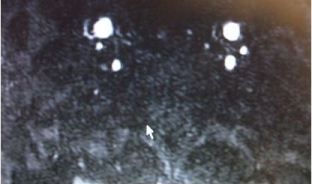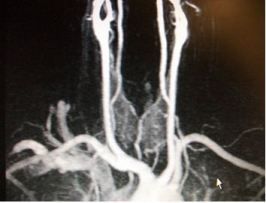Vertigo After a Car Accident: Vertebral Artery Dissection?
Vertebral artery dissection may be misdiagnosed as post-concussive syndrome, stroke, or TIA, based on neurologic symptoms. Always consider after neck trauma.

Figure 1.
A woman in her 40s presented to the emergency department (ED) complaining of right shoulder and neck pain that started after her car was hit by a truck. She had no other complaints. Plain films of the shoulder and cervical spine were negative and she was sent home.
Eight days later, the patient returned to the ED. Although her pain had improved, she now had severe vertigo and a mild headache. She reported vomiting occasionally, but denied any abdominal pain. A neurologic evaluation and a CT scan of the head found no abnormality. The patient was given a diagnosis of post-concussive syndrome and, again, sent home, with prescriptions for ondansetron and meclizine.
Two days later, the patient returned yet again, with persistent vertigo, but no new symptoms. She stated that the vertigo-a spinning feeling that was nonpositional-had gotten worse. During the examination, the patient kept her eyes closed because it mitigated her symptoms. Her neurologic examination was once again unremarkable except for nystagmus. Romberg test results were normal, and there was no dysmetria. Results of finger-nose-finger, heel-shin, and rapid alternating movement testing were all normal.
The progression of the patient’s symptoms suggested an occult injury. To investigate further, the ED physician at this visit ordered a carotid and vertebral arterial duplex ultrasound examination, the results of which were markedly abnormal. Results of a subsequent magnetic resonance angiography (MRA) study of the neck are shown in Figure 1.
What’s your diagnosis and how would you treat this patient? Answer and Discussion on Next Page
ANSWER: Right vertebral artery dissection.

Figure 2.
As illustrated by the MRA study in Figure 1 (previous page) filling of the right vertebral artery is compromised compared with that of the left, a finding that confirms the diagnosis of arterial dissection. Figure 2 presents a 3-D reconstruction of the arterial circulation of the neck. The thinning of the right vertebral artery is again demonstrated. This lesion was most likely related to the patient’s motor vehicle accident 10 days earlier. A brain MRI/MRA showed multiple strokes in the posterior circulation and a pending basilar arterial occlusion.
The patient was admitted to the hospital. Treatment with heparin and warfarin produced a gradual improvement in symptoms. She was discharged home 6 days later and did well.
Discussion
Vertebral arterial dissection is a rare cause of neck pain and also a rare cause of stroke. The diagnosis should be considered after major neck trauma or whenever neck injury is followed by neurologic symptoms or signs. Pain is usually present in the posterior-lateral neck and may initially mimic a muscular strain. Neurologic symptoms are caused by emboli or thrombus, which originate at the site of the vascular injury and usually present in a delayed fashion, classically within 1 to 2 weeks of injury. Vertigo, ataxia, and cranial nerve deficits are the usual results of posterior circulation, TIAs, or strokes. Although minor trauma rarely causes vascular injury, cases of vertebral artery dissection have been reported following very low-energy mechanisms, even prolonged upward gaze while painting a ceiling or other overhead object.
For low-risk patients, duplex ultrasonography is a good screening test that is relatively inexpensive and involves no IV contrast, no radiation, and essentially no risk. For patients in whom concern is high, CT angiogram or MR angiogram should be performed. If dissection of the carotid or vertebral artery is diagnosed, a neurosurgeon or at least a neurologist should be consulted. Operative intervention is rarely required, but most cases are managed with prolonged anticoagulation to prevent stroke, until vascular healing is complete. See the Table (below) for more details.